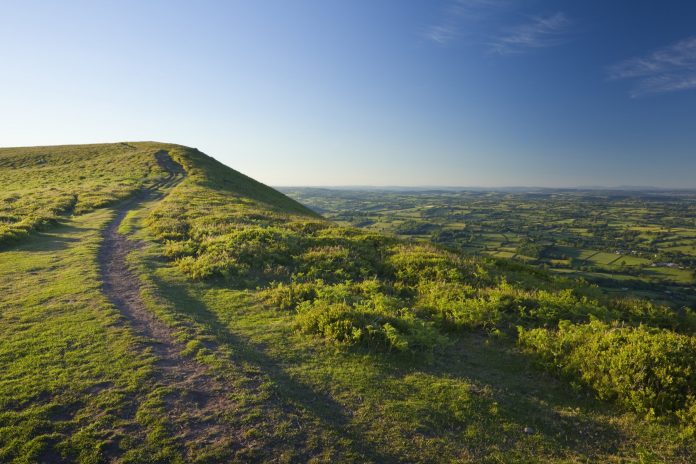It may only look like an 8m high mound of earth, but in reality it is the longest planned ancient monument in Northern Europe. Offa’s Dyke is a man-made letter of intent from an 8th century king and remains part of our cultural heritage.
Offa’s Dyke Path National Trail, one of 16 National Trails in England and Wales, runs next to it and is celebrating its 50th anniversary this year. Look out for a redesigned visitor center in the Welsh border town of Knighton, local walking festivals along the way and a number of new circular walks off the main route. Additionally, with Wales reopened to visitors, the long distance footpath offers breezy days in the thriving countryside of the Welsh-English border.
“I love the variety of landscapes in the sections of the trail – from rolling valleys to heather mountains and verdant forests,” said Rob Dingle, National Trail Officer, who has led the trail for 14 years. “The contrast between the highlands of the Brecon Beacons and the lowlands of the Wye Valley and the rolling Shropshire Hills make every day of walking appear different.”
The latest exclusive and sharpest analyzes, curated for your inbox
I walk one day of the 177 mile trail that runs from near Chepstow on the River Severn to Prestatyn on the North Wales coast. The path is divided into 12 sections with many accommodations and refreshment stops along the way. I joined the trail in the rural hamlet of Castle Mill, just beyond the grounds of the Chirk Castle estate in North Wales, and headed south towards the Shropshire border, following the acorn marker on the National Trail to see the memorial in a farm field View of the Cheshire Plain.
Offa’s Dyke shield near Bigsweir (Photo: David Cheshire / Universal Images Group via Getty Images)
King Offa of Mercia (now the Midlands) ordered the construction of the dike around AD 785 to mark a de facto border between England and the insurgent Welsh tribes to the west.
But unlike Hadrian’s Wall with its mile castles and its functional role in collecting taxes, Offas Dyke was more a symbol of English military power at a time when the Welsh were fighting for independence from their Marcher overlords. The perched bank would witness bitter fighting between rival fiefdoms that ran bloody for centuries until Edward I put down the Welsh rebellion in the late 13th century.
About 40 percent of the Offa dyke path still clings to the original memorial, dug in by the roof and eroded by frost and sometimes surfing on its high bank with a deep trench on its west side. It makes a series of cross-border forays between England and Wales about 26 times along its length.
A shadow figure
“King Offa is something of a shadowy figure from history, but we know he really wanted to expand his kingdom, and the design of the Dykes was very deliberate and served as a warning shot to the west,” explains Rob as we look over into the Ceiriog Valley and the Berwyn Range beyond, examples of 200 year old birch and beech trees surround us.
From here the path meanders to a steep gorge in the Nanteris Forest, where we stop for sandwiches and coffee from pre-packaged bottles before we stock up on snacks in the direction of the border village Trefonen with its small village shop. *
The nearest facility at Llanymynech is eleven miles yet, so Rob and I take our steps back and enjoy the afternoon sun breaking through the spring wind clouds to spot early bluebells and forest anemones poking their sleepy heads over the earth after winter . Buzzards patrol this northern section of the trail while red kites are more common in sections of Mid Wales.
Back in Chirk, I take a short detour from the path that continues to the World Heritage Site Pontcysyllte Aqueduct near Llangollen and go into the forest at Chirk Castle to find the Gate of the Dead.
The scene of a bloody battle
Chepstow Castle is close to the trail (Photo: Jim Dyson / Getty Images)
The gnarled oak from the 11th century marks the scene of one of the bloodiest battles ever fought on the dike. King Henry II led an army of 30,000 soldiers against the Welsh forces at the Battle of Crogen in 1165, led by Owain Gwynedd. The impenetrable, tangled forest formed the blood-stained killing site, and the ancient oak still marks the mass grave of the murdered foot soldiers, whose bodies were piled up in the ditch next to the dike.
“There are many places of historical interest near the trail, such as Chepstow Castle and Bronze Age burial sites in the Clywdian Range and Dee Valley AONB,” says Rob Dingle, whose favorite section of the trail visits the ancient Dinas Bran Castle near by Llangollen in North Wales.
“To me,” he adds, “walking along the way feels like walking through history.”
Where to visit
Chepstow Castle, free entry, cadw.gov.wales
White Castle, Abergavenny, free entry, cadw.gov.wales
Llanthony Priory, free entry, cadw.gov.wales
Hergest Croft Gardens, £ 7, hergest.co.uk
Offa’s Dyke Center in Knighton is currently closed, offasdyke.org.uk
Powis Castle and Garden, £ 10, nationaltrust.org.uk/powis-castle-and-garden
Chirk Castle. The castle will remain closed until July 5th, but the property is open, £ 8, nationaltrust.org.uk/chirk-castle
Pontcysyllte Aqueduct World Heritage Site, pontcysyllte-aqueduct.co.uk
More information
Offa’s Dyke Path 50th anniversary events, including 25 themed routes, will be announced through nationaltrail.co.uk
The Offas Dyke Association, offasdyke.org.uk
A new ITV series on Offa’s Dyke Path, Wonders of the Border, hosted by Sean Fletcher, will air this summer
visitwales.com

